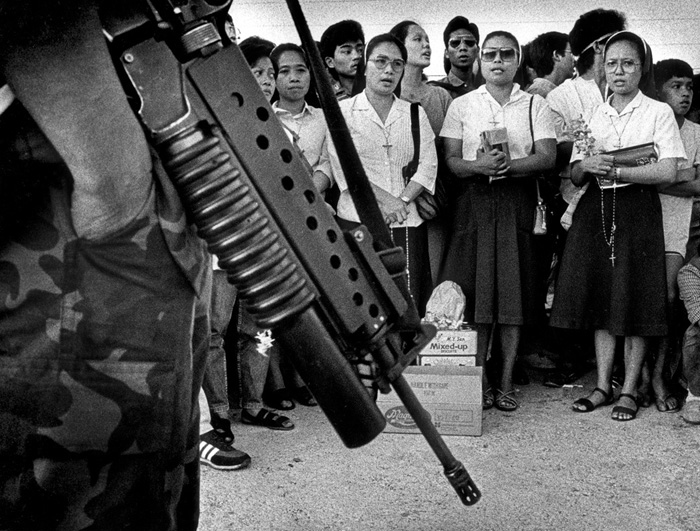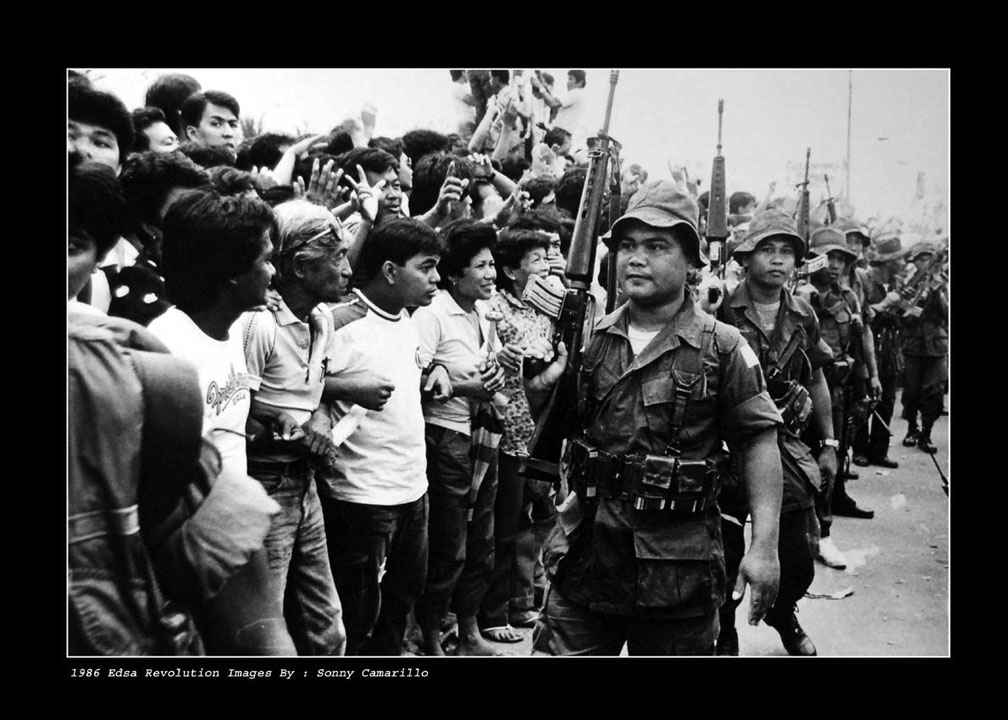By JOANNE RAE RAMIREZ
Of course it does. It was an exercise in freedom and democracy that was a tribute to humanity and its basic desire to live free, unchained from the shackles of totalitarian rule. EDSA showed political science experts around the world that a peaceful revolution is doable. EDSA married the words “people” and “power.”
(People gather at the Kalayaan grounds inside Malacañang in 1986 | Photo by VAL RODRIGUEZ)
Isabella, a 23-year-old writer, says EDSA and its gains go beyond “even the country where it all happened.”
EDSA was a template that many freedom movements and marches — from Berlin to Beijing (remember the man who stopped the tanks on Tiananmen Square?), from Poland to the Middle East (the “Arab Spring”) — took inspiration from.
It was, as Paolo, a 31-year-old editor, pointed out, a revolution of not just one family but of at least a million people.
And though I believe unequivocally that EDSA began with Ninoy Aquino, it does not end with the Aquinos. Shouldn’t end after the term of the second President Aquino. To make it irrelevant now would be to blur the bravery, selflessness and patriotism of those who faced up to the muzzle of the soldier’s gun on the concrete freedom battlefield that was EDSA.
This year is a test of how much EDSA as a political phenomenon, as an uprising that shifted the plates of the global political landscape, still matters.
The last 30 years saw Presidents who were identified with EDSA ‘86. Cory Aquino was catapulted to the presidency by EDSA, and she sought to steady the ship of state as it was navigating the stormy transition from dictatorship to a democracy. Fidel V. Ramos is a hero of the EDSA Revolution, his breakaway from President Ferdinand Marcos, his cousin, emboldening many to rise against the dictatorship as well. After barely two years as vice president, Gloria Macapagal Arroyo was catapulted to the presidency as well by a peaceful people power uprising inspired by EDSA ‘86. And Noynoy Aquino, the only son of Ninoy and Cory, kept the EDSA flame alive.
This year, EDSA is going it alone. Its major players are no longer in power. On second thought, all of us who were on EDSA were major players of that revolution. And we are still here. Jaime Cardinal Sin, Cory Aquino and Butz Aquino may have passed on, and Fidel Ramos and Juan Ponce-Enrile may have retired from public office — but you and I are still here.
Let’s not let the gains of EDSA be forgotten.
So will people stop and honor that day in 1986 when the world stood in awe of a peaceful revolution that ended 30 years of totalitarian rule without blood on the streets?
You don’t have to march on the streets to honor EDSA.
(Pulitzer Prize-winning photo by Kim Komenich shows nuns forming the first line of defense against Marcos troops on EDSA on Feb. 23, 1986)
So, this is my EDSA story.
My parents (Frank and Sonia Mayor) did not discourage their four daughters from attending pro-democracy rallies in the mid-‘80s. My husband Ed, then a creative director for advertising firm Bates Alcantara, shared my parents’ political sentiments. Just before EDSA, he accompanied my mom and my sister Valerie to Mendiola, where they joined the crowd calling for Marcos to step down. They brought home a piece of the barbed wire from the barricades, and that piece of barbed wire is reverently stored in my mother’s Las Piñas home to this day.
But I wasn’t with Ed in Mendiola — because I was heavy with our child Chino. So while they were on the frontlines, I was busy in another battleground, the Cory Aquino Media Bureau, set up in the Jose Cojuangco and Sons building in Makati. Here we fought the propaganda war against the dictatorship with guts and imagination and some borrowed typewriters.
I was recruited to join the media bureau by my UP classmate Isaac Belmonte (now The Philippine STAReditorial board head). Like millions of Filipinos, I had reached that point in my life when I wanted to see change and was willing to not just be a “witness” to it, but also a “weapon” to usher it in. So I said, “Count me in.”
I reported every day to our headquarters as a volunteer writer and took instructions from Billy Esposo,Popoy Juico, Ed Zialcita, Teddyboy Locsin and Rene Saguisag. We issued daily press bulletins to compete with those issued by the well-oiled Marcos machinery. (In the beginning, supporters sent us day-old donuts and tuna sandwiches. After EDSA, they sent food in chafing dishes, with matching table linen!)
I remember Pearlie Arcache Morales, one of my fellow volunteers at the media bureau, who sat squarely on one of the ballot boxes in a precinct in Guadalupe when pro-government goons threatened to steal them. She was the mother of a little girl at the time, but she bravely stared down the barrel of a rifle. Guess who blinked?
Though I missed Mendiola, I wanted to be counted at EDSA. I was doing it for myself and for my unborn child. When he grew up, I didn’t want him to live in fear of being sent to prison if he disagreed or opposed the powers-that-be. I wanted him to vote in clean and honest elections wherein his vote would be counted.
I’m sure my OB-Gyne would have been horrified then if she knew that I was at EDSA. My concern then was not that I would be injured — I had faith that I wouldn’t — but that there wouldn’t be a nearby toilet when the need arose! I hurdled all obstacles, thankfully.
The euphoria I felt when Ferdinand Marcos fled, and the distinction I still feel now at having participated in a moment that changed the course of history, made it all worthwhile. You didn’t go to EDSA with a death wish — you wanted to live more than ever that’s why you were there — but you were willing to risk your very life for a cause greater than yourself.
(People on EDSA form a human chain in front of military men as they participate in the peaceful people power uprising that took place from Feb. 23 to 25, 31 years ago | Photo by SONNY CAMARILLO)
Soon, the child I carried in my womb while I faced the tanks on EDSA will be turning 31. He is the cause greater than myself.
Despite the nagging headaches of an imperfect democracy, he will never have to look over his shoulder if ever he utters anything against the government (well, he will just have to contend with “trolls” on social media). He can vote for whoever he wants, without fear that his vote won’t be counted. He pays his taxes and knows his President won’t steal it.
Before the 2016 elections, a Cabinet official told a group of women in media that he was not afraid that Candidate X would end up President. His explanation: media and social media.
That is a legacy of EDSA.
Freedom of the press, though sometimes abused, is a gift the post-EDSA generation should never, ever take for granted. To have a watchdog of government that is free and unencumbered adds to a citizen’s worth.
Before EDSA, all this was like shooting the moon.
EDSA was real. It wasn’t just a dream. And we should continue making its gains a reality.
This article was originally published in The Philippine STAR’s Allure section on Feb. 23, 2017.








